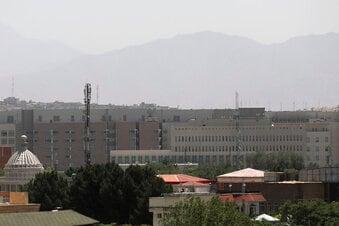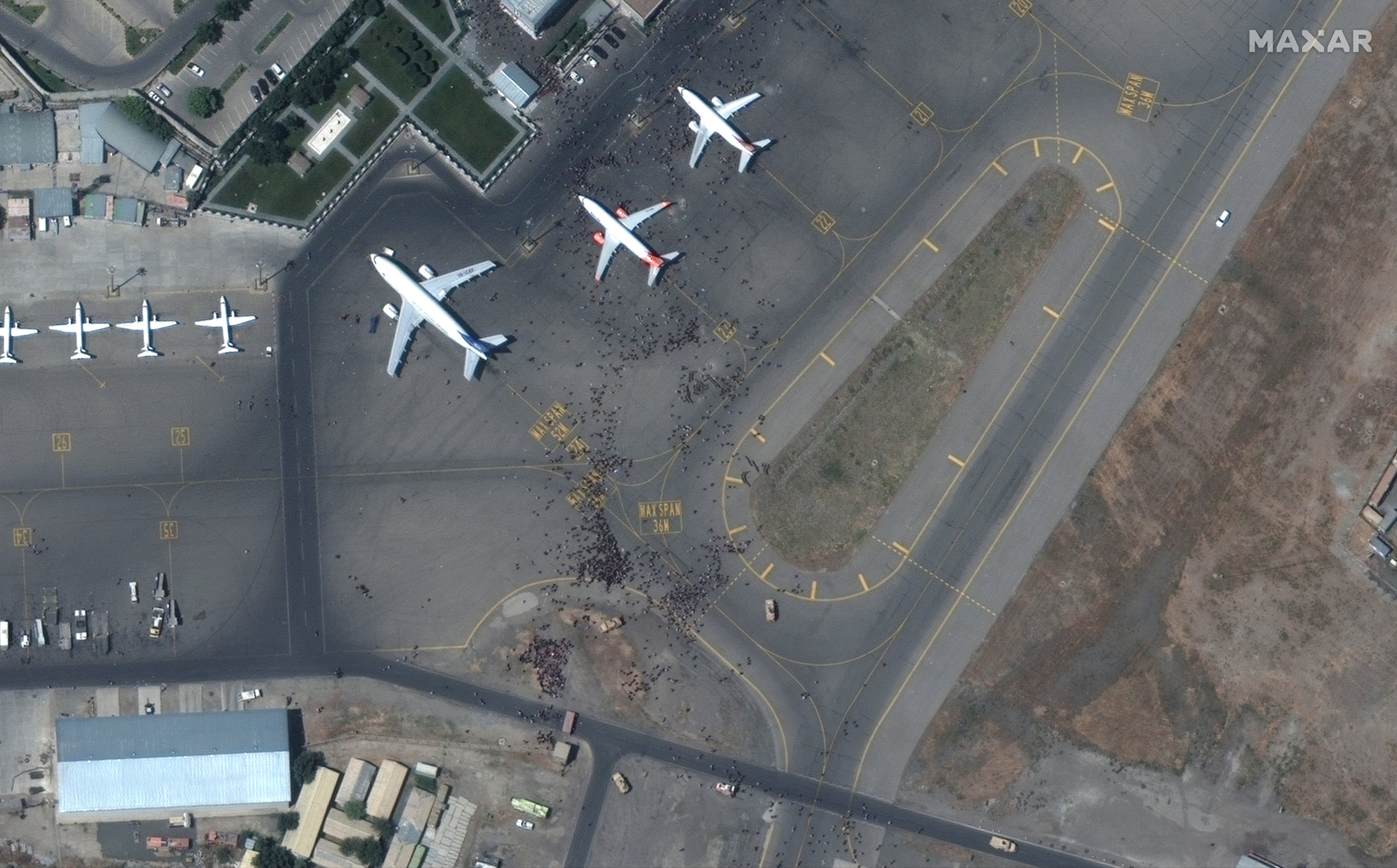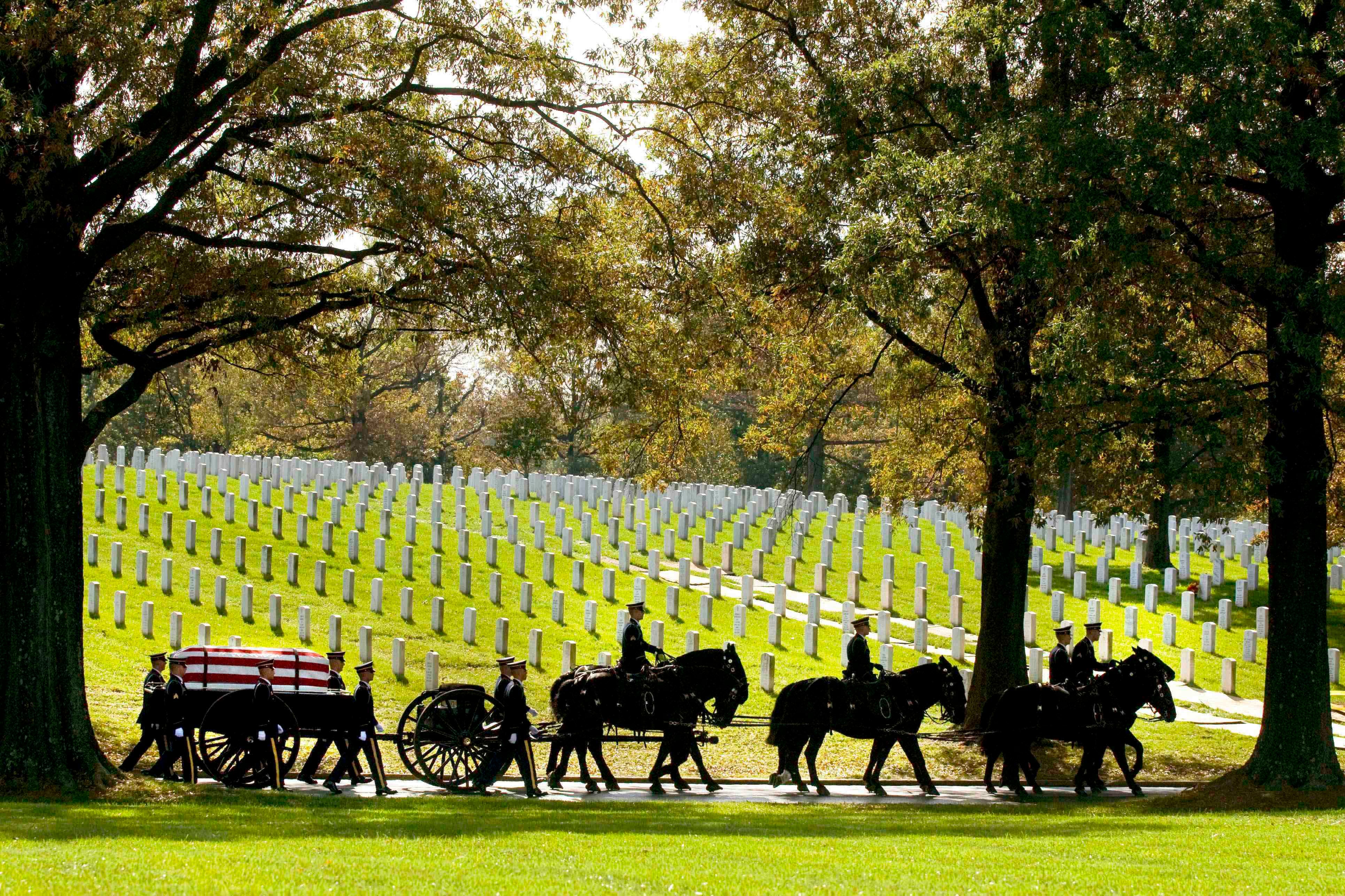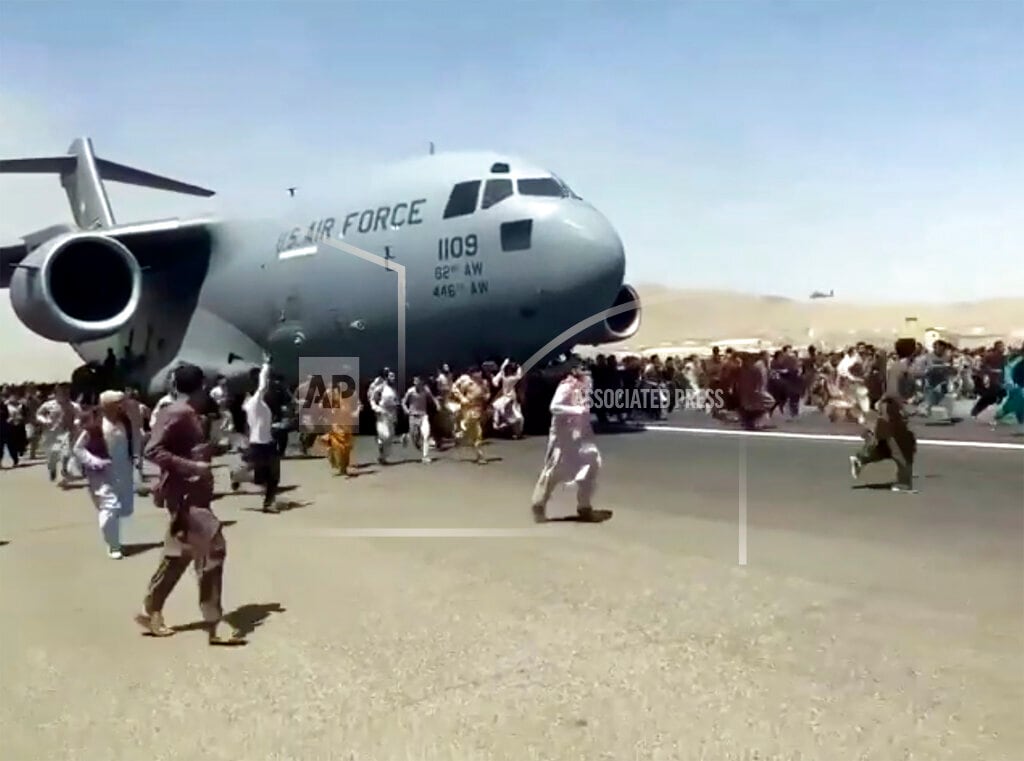This story is part of the portfolio that won the 2023 Society for Professional Journalists Dateline Award for beat reporting in a newsletter or trade publication.
In just a matter of days, Kabul’s Hamid Karzai International Airport has transformed into a scene of desperation as thousands of Afghans and Americans alike try to flee the resurgent Taliban through Afghanistan’s last airborne escape route.
But evacuating to the U.S. some 22,000 Afghans who risk death if they stay in a country that has swiftly fallen under Taliban rule, as well as rescuing Americans and foreign allies still in the beleaguered nation, is growing increasingly complicated.
The Bagram and Kandahar airfields — former military aviation hubs for the U.S.-led coalition — are now in the hands of the Taliban. That leaves the Kabul airport’s single runway as the sole remaining option for getting people to safety.
And it’s happened much faster than the Biden administration anticipated.
RELATED

“All of our plans were predicated on the notion that we thought that the Afghans were going to be able to hold Kabul,” said William Wechsler, a Middle East expert at the Atlantic Council who served as deputy assistant secretary of defense for special operations and combating terrorism in the Obama administration.
“Get everyone out that needs to get out, take them to some place where they can then be sorted through, and send some people back that … should not have been taken out in the first place,” he said.
Now the U.S. and its allies must work through a unique set of challenges: securing and controlling evacuation work at the shared civilian-military airport amid chaos; vetting tens of thousands of people afraid of being left behind, and keeping the Taliban at bay.
The Biden administration should deem the effort a “noncombatant evacuation operation,” which would trigger a formal set of steps for an orderly departure, Wechsler said.
He suggested the U.S. and its allies may need a greater military presence at the airport to maintain control of the entire site while tens of thousands of people process through. The Pentagon estimates it can ferry about 5,000 people out of Afghanistan each day.
RELATED

“The forces required for the [evacuation], backed by continuous direct diplomacy with the Taliban, should be sufficient to deter any disruption of the evacuation process,” Wechsler argued in an Atlantic Council post on Sunday.
Command and control of U.S. jets going into and out of Kabul partially falls to airmen manning the Combined Air Operations Center at Al Udeid Air Base in Qatar. They handle matters like scheduling the lineup of planes at the Afghan airport and coordinating the movement of air traffic, but maintaining calm and order on the ground remains outside of their purview.
That struggle was made plain Monday, when all air operations at the Kabul airport temporarily stopped due to security concerns posed by insurgent fighters who have gained control of the Afghan capital, as well as throngs of Afghan citizens swarming the facility in an attempt to leave.
No military or civilian aircraft could enter or exit the airport while American forces in AH-64 Apache helicopters tried to clear people from the tarmac.
The single runway was mobbed as a U.S. Air Force transport jet, a C-17 Globemaster III from Joint Base Lewis-McChord in Washington state, carved its way through the crowd. Videos showed frantic Afghans running alongside the massive aircraft, clinging to its sides and — for a tragic few — plummeting back to earth as the C-17 climbed into the sky.
At least seven people have died in the airport melee, the Associated Press reported Monday, citing senior U.S. military officials. American troops killed two people who were carrying weapons, Pentagon spokesman John Kirby said.
Bob Holmes, a retired Air Force brigadier general who served as deputy operations director for U.S. Central Command, expressed optimism that the Marine Corps may be able to help stabilize the situation as thousands of U.S. troops deploy to Kabul.
“The Marines are good at this. They know how to do expeditionary operations. They know how to command and control airfields,” he told Air Force Times on Monday. “I would like to think that the Marines are somewhat able to be in charge of that.”
The U.S. may get some respite from an unlikely ally: The Taliban established a 2-kilometer buffer zone around the airport to keep Afghans from rushing the building and airfield, said Joe Saboe. The former U.S. Army infantry officer who served in Iraq now acts as a spokesman for a group of former U.S. military and federal employees who are trying to help more than 50 people leave Afghanistan.
RELATED

“Time needs to be on their side,” Holmes added. “The more you can do to calm things down, that’s what you’re really going to need, because minutes are precious.”
Chaos will prove more restrictive to the evacuation effort than the military’s work to rally airlifters and land them in Kabul, he said. He believes it’s more important to know what to do with evacuees when they arrive and establish an orderly system for processing them.
The U.S. has already evacuated 2,000 Afghans who were eligible for special immigrant visas, President Joe Biden said in a televised address Monday. Biden said his administration intends to move visa-eligible Afghans, American citizens, civilian employees of allied countries, and “other vulnerable Afghans who work for our embassy” out of the country.
One stunning C-17 flight carried about 640 refugees to Qatar on Sunday — a crowd believed to be among the largest ever flown on the Globemaster III, Defense One reported Monday. The military declined to answer a query from Air Force Times on the flight by the 436th Airlift Wing out of Dover Air Force Base, Delaware.
“Panicked Afghans who had been cleared to evacuate pulled themselves onto the C-17′s half-open ramp. … Instead of trying to force those refugees off the aircraft, ‘the crew made the decision to go,’” a military official told Defense One. Several other jets also reportedly took off with hundreds of people on board.
If the U.S. tried to set up another evacuation site to ease pressure on the airport, they would need to secure and control it — but it’s unclear whether that’s possible right now, Holmes said. Then there’s the tricky logistics of getting evacuees to multiple sites.
“Adding an extra departure point is only as good if you’ve got the forces in-country to now collect and deliver to two departure points, or three, or four,” he said. “You’re going to be constrained by finding these folks and getting them to whatever this departure airfield is.”
Multiple federal officials declined to comment on the current state of air operations in Afghanistan. U.S. Transportation Command, Air Forces Central Command and the State Department referred questions on evacuation flights to the Office of the Secretary of Defense, which did not respond.
Bombing may be underway in the capital of 5 million people, if briefly. The AP reported Monday that one of its journalists “saw what appeared to be an airstrike target two vehicles near the airport.”
When asked whether aircraft that were recently dispatched for last-ditch airstrikes inside the country, including platforms like B-52 bombers and AC-130 gunships, are still operating, AFCENT spokesman Phil Ventura replied, “Out of concern for operational security, we have nothing to share … regarding force posture at this time.”
Enemy forces have so far held their fire as U.S. jets rotate in and out of Kabul. The city is flanked by mountains that stretch across much of the country and have hidden insurgents during the 20-year war, raising further security concerns about ambushes amid the withdrawal.

In a face-to-face meeting with senior insurgent leaders in Qatar Sunday, U.S. Central Command boss Gen. Frank McKenzie “won Taliban agreement to establish a ‘deconfliction mechanism’ — an arrangement by which evacuation operations at the airport can continue without interference by the new rulers of the country,” The Associated Press reported.
Experts who spoke to Air Force Times believe the Taliban are unlikely to renege on their agreement by firing surface-to-air missiles at transport planes. Taking foreign hostages is more likely, Wechsler said, even if the Taliban or other groups aren’t trying to interrupt the evacuation itself.
“Hostage-taking is already a tool that the Taliban uses without shame,” he wrote. “A dedicated U.S. special operations team should be reinserted to move quickly to rescue such hostages if the opportunity arises.”
Holmes noted that military pilots can descend into the airfield in a way that minimizes the risk of attack — but it isn’t foolproof.
“I would like to think that there would be an indication that they would not try to shoot down an aircraft,” he said. “But again, who knows? We’ve never quite gauged this enemy after 20 years.”
James Webb of Military Times contributed to this story.
Editor’s note: This story has been updated to reflect that the C-17 from Washington state was based at Joint Base Lewis-McChord but was not flown by JBLM airmen at the time.
Rachel Cohen is the editor of Air Force Times. She joined the publication as its senior reporter in March 2021. Her work has appeared in the Washington Post, the Frederick News-Post (Md.), Air and Space Forces Magazine, Inside Defense, Inside Health Policy and elsewhere.





